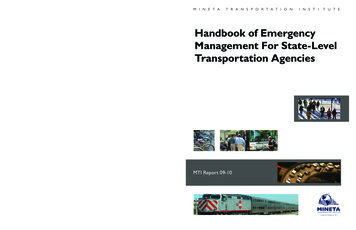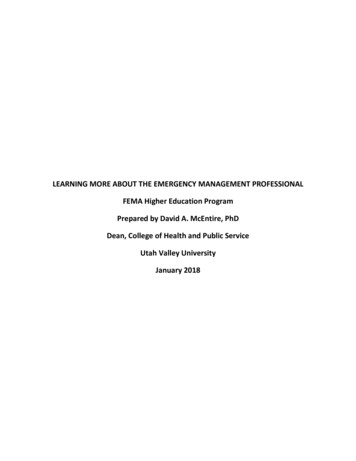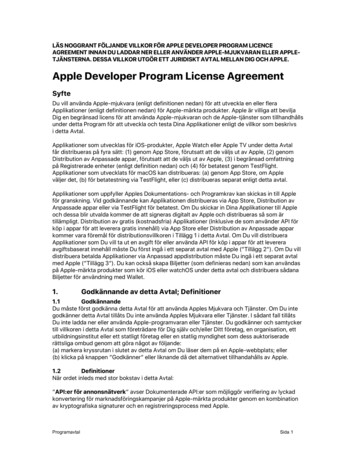
Transcription
MTIHandbook of Emergency Management For State-Level Transportation AgenciesFunded by U.S. Department ofTransportation and CaliforniaDepartment of TransportationHandbook of EmergencyManagement For State-LevelTransportation AgenciesMTI Report 09-10MTI Report 09-10February 2010
MINETA TRANSPORTATION INSTITUTEMTI FOUNDERHon. Norman Y. MinetaThe Norman Y. Mineta International Institute for Surface Transportation Policy Studies (MTI) was established by Congress as partof the Intermodal Surface Transportation Efficiency Act of 1991. Reauthorized in 1998, MTI was selected by the U.S. Departmentof Transportation through a competitive process in 2002 as a national “Center of Excellence.” The Institute is funded by Congress through the United States Department of Transportation’s Research and Innovative Technology Administration, the California Legislature through the Department of Transportation (Caltrans), and by private grants and donations.The Institute receives oversight from an internationally respected Board of Trustees whose members represent all major surfacetransportation modes. MTI’s focus on policy and management resulted from a Board assessment of the industry’s unmet needsand led directly to the choice of the San José State University College of Business as the Institute’s home. The Board providespolicy direction, assists with needs assessment, and connects the Institute and its programs with the international transportationcommunity.MTI BOARD OF TRUSTEESHonorary Co-ChairHon. James Oberstar **ChairHouse Transportation andInfrastructure CommitteeHouse of RepresentativesWashington, DCHonorary Co-ChairMTI’s transportation policy work is centered on three primary responsibilities:ResearchMTI works to provide policy-oriented research for all levels ofgovernment and the private sector to foster the developmentof optimum surface transportation systems. Research areasinclude: transportation security; planning and policy development; interrelationships among transportation, land use, and theenvironment; transportation finance; and collaborative labormanagement relations. Certified Research Associates conductthe research. Certification requires an advanced degree, generally a PhD, a record of academic publications, and professionalreferences. Research projects culminate in a peer-reviewedpublication, available both in hardcopy and on TransWeb, theMTI website (http://transweb.sjsu.edu).EducationThe educational goal of the Institute is to provide graduate-leveleducation to students seeking a career in the development andoperation of surface transportation programs. MTI, through SanJosé State University, offers an AACSB-accredited Master of Science in Transportation Management and a graduate Certificatein Transportation Management that serve to prepare the nation’stransportation managers for the 21st century. The master’s degree is the highest conferred by the California State Universitysystem. With the active assistance of the California Departmentof Transportation, MTI delivers its classes over a state-ofthe-art videoconference network throughout the stateof California and via webcasting beyond, allowing workingtransportation professionals to pursue an advanced degreeregardless of their location. To meet the needs of employers seeking a diverse workforce, MTI’s education programpromotes enrollment to under-represented groups.Information and Technology TransferMTI promotes the availability of completed research toprofessional organizations and journals and works tointegrate the research findings into the graduate educationprogram. In addition to publishing the studies, the Institutealso sponsors symposia to disseminate research results totransportation professionals and encourages Research Associates to present their findings at conferences. The Worldin Motion, MTI’s quarterly newsletter, covers innovationin the Institute’s research and education programs. MTI’sextensive collection of transportation-related publicationsis integrated into San José State University’s world-classMartin Luther King, Jr. Library.DISCLAIMERThe contents of this report reflect the views of the authors, who are responsible for the facts and accuracy of the information presented herein. This document is disseminated under the sponsorship of the U.S. Department of Transportation, University Transportation Centers Programand the California Department of Transportation, in the interest of information exchange. This report does not necessarily reflect the officialviews or policies of the U.S. government, State of California, or the Mineta Transportation Institute, who assume no liability for the contents oruse thereof. This report does not constitute a standard specification, design standard, or regulation.Hon. John L. Mica**Ranking MemberHouse Transportation andInfrastructure CommitteeHouse of RepresentativesWashington, DCDavid L.Turney*Chair/President/CEODigital Recorders, Inc.Dallas, TXWilliam W. MillarRebecca BrewsterSteve HemingerStephanie PinsonPresident/COOAmerican TransportationResearch InstituteSmyrna, GAExecutive DirectorMetropolitan TransportationCommissionOakland, CAPresident/COOGilbert Tweed Associates, Inc.New York, NYDonald H. CamphPresidentCalifornia Institute forTechnology ExchangeLos Angeles, CAAnne P. CanbyPresidentSurface TransportationPolicy ProjectWashington, DCVice Chair/PresidentAmerican Public TransportationAssociation (APTA)Washington, DC#Executive DirectorMineta Transportation InstituteSan Jose, CAPresidentDMJM HarrisWill KemptonNew York, NYPresident/CEOGranite Construction, Inc.Watsonville, CAChairmanPB Consult Inc.Washington, DCNuria FernandezRonald BarnesGeneral ManagerVeolia Transportation/EastValley RPTAJoseph BoardmanJane ChmielinskiMortimer DowneyHon. Rod Diridon, Sr.Executive DirectorAmerican Association of StateHighway & TransportationOfficials (AASHTO)Washington, DCPresident/CEOAmtrak60 Massachusetts Ave., N.E.Washington, DC 20002William Dorey Hans RatHon. John Horsley #CommissionerCity of Chicago,Department of Aviation,DirectorCalifornia Department ofTransportationSacramento, CABrian MacleodSenior Vice PresidentGillig CorporationHayward, CADr. Bruce MagidDeanCollege of BusinessSan José State UniversitySan José, CASecretary GeneralUnion Internationale desTransports PublicsBruxelles, BelgiumVickie ShafferGeneral ManagerTri-State Transit AuthorityHuntington, WVPaul Toliver #PresidentNew Age IndustriesSeattle, WAMichael S.Townes #President/CEOTransportation DistrictCommission of Hampton RoadsHampton, VAEdward WytkindPresidentTransportation TradesDepartment, AFL-CIOWashington, DC***Chicago, IL #Mesa, AZHonoraryChairVice ChairPast ChairDirectorsResearch Associates Policy Oversight CommitteeHon. Rod Diridon, Sr.Asha Weinstein AgrawalRon SylviaExecutive DirectorUrban and Regional PlanningPolitical ScienceDr. Karen E. PhilbrickJoe GiglieranoTaeho ParkResearch DirectorMarketing and Decision ScienceOrganization and ManagementDr. Peter HaasDr. Jan BothaDiana WuMTI DirectorProfessor, Dept. of Civil &Environmental EngineeringSan José State UniversityResearch LIbrarianMartin Luther King, Jr. LibrarySan José State UniversityDonna MaurilloCommunications Director
MTI Report 09-10Handbook of EmErgEncymanagEmEntforStatE-LEvEL tranSportationagEnciESMarch 2010Frances L. Edwards, MUP, PhD, CEMDaniel C. Goodrich, MPA, CEMa publication of theMineta Transportation InstituteCollege of BusinessSan José State UniversitySan José, CA 95192-0219Created by Congress in 1991
Technical Report Documentation Page1.Report No.4.Title and Subtitle7.9.CA-MTI-10-28502.Government Accession No.Handbook of Emergency Management For State-Level TransportationAgenciesAuthorsFrances L. Edwards, MUP, PhD, CEM andDaniel C. Goodrich, MPA, CEMRecipients Catalog No.5.Report Date6.Performing Organization Code8.Performing Organization Report No.March 2010MTI Report 09-10Performing Organization Name and AddressMineta Transportation InstituteCollege of BusinessSan José State UniversitySan Jose, CA 95192-021910. Work Unit No.11. Contract or Grant No.DTRT 07-G-005412. Sponsoring Agency Name and AddressCalifornia Department ofTransportationSacramento, CA 94273-00013.U.S. Department of TransportationOffice of Research—MS42Research & Special ProgramsAdministrationP.O. Box 942873400 7th Street, SWWashington DC 20590-000113. Type of Report and Period CoveredFinal Report14. Sponsoring Agency CodeU.S. Department of Homeland SecurityScience and Technology DictorateWashington, DC 2052815. Supplementary Notes16. AbstractThe Department of Homeland Security has mandated specific systems and techniques for the management of emergenciesin the United States, including the Incident Command System, the National Incident Management System, EmergencyOperations Plans, Emergency Operations Centers, Continuity of Government Plans and Continuity of Operations Plans.These plans and systems may be applied to the state-level transportation agency’s disaster response systems to enhanceefficiency and effectiveness. Specific guidance and management techniques are provided to aid emergency planning staffto create DHS-compliant systems.17. Key WordsDisasters and emergencyoperations; Disasterpreparedness; Emergencytraining; Hazards and emergencyoperations18. Distribution Statement19. Security Classif. (of this report)20. Security Classifi. (ofthis page)UnclassifiedUnclassifiedForm DOT F 1700.7 (8-72)No restrictions. This document is available to the public throughThe National Technical Information Service, Springfield, VA 2216121. No. ofPages11422. Price 15.00
Copyright 2010by Mineta Transportation InstituteAll rights reservedLibrary of Congress Catalog Card Number: 2010922582To order this publication, please contact the following:Mineta Transportation InstituteCollege of BusinessSan José State UniversitySan José, CA 95192-0219Tel (408) 924-7560Fax (408) 924-7565email: mti@mti.sjsu.eduhttp://transweb.sjsu.edu
acknoWLEdgmEntSThe initial impetus for this work was the development of materials to assist the CaliforniaDepartment of Transportation (Caltrans) Headquarters with the continuous improvementcycle of their emergency management system. One focus was on the revision of theirContinuity of Operations/Continuity of Government Plan, while another was on theirparticipation in Golden Guardian 2007. Ken De Crecenzo, Jerry Knedel and Kathy Golbergwere active partners in this effort.The initial draft versions of these materials were used in planning for California’s annualGolden Guardian exercise in October, 2008. The Caltrans role as a state-level agencysupporting the Governor was researched and new guidance materials were developedbenefitting from the in-house knowledge available through experienced Caltrans staff.Special thanks are due to Randy Iwasaki, now director of Caltrans, Mike Miles and HerbyLissade for their partnership in developing and reviewing new elements for the CaltransContinuity of Government and Continuity of Operations Plans (COOP/COG). WilliamMedigovich provided expert level information on the role of transportation in emergencyoperations. His executive level exercise materials and his work on the COOP/COG plandevelopment were crucial elements of this research. The authors owe a debt of gratitudeto the Caltrans Emergency Operations Steering Committee for their useful comments onthe materials and their ideas for inclusion of additional topics.The Mineta Transportation Institute was the direct sponsor and overseer of theproject. Research Director Karen Philbrick, PhD, provided the impetus for thecreation of this report, and Executive Director Rod Diridon has contributed acontinuing focus on emergency management in the Institute that led to the issuance ofthis report.The authors also thank MTI staff including Director of Communications and SpecialProjects Donna Maurillo, Research Support Manager Meg Fitts, Student ResearchSupport Assistant Chris O’Dell, Student Publications Assistant Sahil Rahimi, StudentGraphic Artists JP Flores and Vince Alindogan, and Student Webmaster Ruchi Arya.Special thanks are due to Editorial Associate Catherine Frazier, whose patience andcreativity are reflected in the finished product.
itable of ContentsEXECUTIVE SUMMARY 1INTRODUCTION 3LITERATURE REVIEW 7METHODOLOGY 11HISTORY OF CONTINUITY OF OPERATIONS PLAN (COOP)/CONTINUITY OFGOVERNMENT (COG) 13Cold War 13Oklahoma City Bombing 14Post 9/11 Federal Mandates 14Hurricane Katrina 15Scenarios Requiring the Implementation of COOP/COG 16THE ROLE OF THE EMERGENCY SERVICES MANAGER IN A STATETRANSPORTATION AGENCY 21Pre-Disaster Planning and Preparedness 22Disaster Response.27Recovery28.Mitigation31THE ROLE OF THE DEPARTMENT OF TRANSPORTATION HEADQUARTER EOC 35Role and Purpose of the Headquarters EOC 35Relationship to the District Field Actions36Relationship to the Regional Emergency Operations Center38Relationships to the State Operations Center38THE HIERARCHY OF EMERGENCY PLANS Mineta Transportation Institute43
iiTable of ContentsAdditional Activities To Lead To A Fully Mature EmergencyManagement Program, Including COOP And COG Within the StateLevel Transportation Agency 47Appendix A: Example Statement of Work for EmergencyManagement Continuous Improvement Cycle49Appendix B: State Transportation Agency Headquarters LevelTabletop Exercise 51APPENDIX C: TYPICAL ESSENTIAL FUNCTIONS LIST 57Appendix D: Model Memo to Director Regarding Placement ofEmergency Manager 61Appendix E: Sample State Disaster service worker Brochure 65Appendix F: Employee emergency kit flier 67Appendix G: Family Emergency Plan Template 69Appendix H: Lines of Succession 71Appendix I: Alternate Facilities for Headquarters 73Appendix J: LIST OF EMERGENCY MANAGEMENT PUBLICATIONS 75Appendix K: Excerpts from a Sample State Emergency OperationsPlan 89ENDNOTES 95Abbreviations, acronyms and Glossary 103BIBLIOGRAPHY 105ABOUT THE AUTHORS 109Peer review 113Mineta Transportation Institute
iiiList of Figures1. An Example of a Disaster Preparedness Exercise in San José 172. Train Disaster Exercise in San José 183. Train Disaster Exercise of San José Fire Department 184. Removing a Window as Part of San José Fire Department Disaster Exercise195. Preparing for a Victim Rescue During Train Exercise in San José 196. St. Tammanay Parish, Louisiana, EOC Sleeping Area 257. St. Tammanay Parish, Louisiana, EOC Living Quarters 268. City of San José EOC Construction and Engineering Branch 279. Emergency Preparedness: Preparing a Section of Highway in San José forMudslide Containment 3210. Emergency Preparedness: Building Trusses to Prevent Mudslides in DowntownSan José 3311. Santa Clara County Fire Department Fire Department’s Technical Assets Truck 3312. Dallas EOC 4013. Dallas’ EOC Radio Room 4014. City of San José EOP Operations Section 4115. San José Fire Department Mobile Emergency Operations Command Van 4116. Interior View City of San José Fire Department’s Mobile Emergency OperationsCommand Van 4217. Additional View San José Fire Mobile Command Van 4218. Montgomery County, Maryland, EOC 74Mineta Transportation Institute
ivList of Figures.Mineta Transportation Institute
vList of TablesTable 1 Federal Aid Highway Emergency Relief Program.Table 2 Categories of Work Under the Stafford Act and DescriptionMineta Transportation Institute2930
viList of TablesMineta Transportation Institute
1EXECUTIVE SUMMARYState transportation agencies are required to have plans for the continuity of their governmentfunctions during any catastrophic disaster, as well as for the continuation of the essentialservices that they provide to the people of the state, other levels of government, otherstate agencies and to federal partners during response, recovery and mitigation phases ofemergency management. Emergency management guidance is normally provided in statelaws, such as an Emergency Services Act, that defines the roles and responsibilities ofstate-level agencies. Headquarters-level Emergency Management Plans (EOP), Continuityof Government (COG) Plans,and Continuity of Operations (COOP) Plans embody theactions of the specific agency in disasters, with appropriate guidance detailed in checklistsand annexes for the various subdivisions of the agency’s headquarters staff.The Incident Command System was created in the 1970s in California by the fire servicefor use in large scale emergencies. Over time it has evolved to the command and controlsystem for all emergencies in California. After the terrorist attacks of September 11, 2001President George W. Bush mandated that all emergency response must be conductedusing the National Incident Management System (NIMS) in order to receive the federalshare of emergency response funds.1 Homeland Security Presidential Directive-5 (HSPD5) was issued by President Bush on February 28, 2003 and ICS became the basis forNIMS.2After Hurricane Katrina there was a new emphasis on catastrophic emergency planning.Transportation is the basis for the ability of all other first responders to fulfill their disasterroles. Without open, clear and safe roadways all other forms of response are slowed orstopped. Therefore a COOP and COG planning process for catastrophic emergenciesis essential to augment the Emergency Operations Plan (EOP) that addresses “normal”emergencies.The overall emergency management structure must be in place to support implementationof the EOP, COOP and COG. The emergency management structure must supportorganization-wide policy setting for the department while also supporting the governor’sneed for information. Such a system requires training of employees on the plans and theirroles, including personal and family emergency preparedness. Exercises are essential toevaluate the success of the training and the completeness of the EOP, COOP and COG. Achain of command including delegation of authority is required, along with alternate EOClocations.Planning must include recovery, with training and documentation for receivingreimbursements from the Federal Highway Administration (FHWA) and the FederalEmergency Management Agency (FEMA), and plans for audit and appeal processes. Postdisaster mitigation measures must also be included, recognizing Disaster Mitigation Act2000 mandates.The role of the emergency operations center (EOC) must be defined and exercised. Itincludes support for the governor’s policy decision making, and facts to assist in settingMineta Transportation Institute
2Executive Summarystatewide priorities for the allocation of scarce resources. The state’s transportation agencyserves as a link between the local governments that need assistance and the state and federalresources that can be activated. As such the state transportation department’s headquartersEOC coordinates with the department’s district EOCs, the state emergency managementagency’s regional EOCs, and the state level operations center to manage resource requestsand delivery of services, based on the department’s essential functions.There is a hierarchy of emergency plans to support emergency response actions. Standardoperations procedures (SOPs) guide behavior at the field level. The EOP guides thedepartment in managing a disaster, while the COOP and COG focus on catastrophic events,and potential the loss of executive leadership and headquarters facilities. Departmentresources must be organized to support the department’s own essential functions, as wellas federal primary essential functions and mission essential functions, as defined in newfederal guidelines.This research project was intended to lay the groundwork for establishing prioritiesthat would lead to a mature management capability for emergencies, disasters andcatastrophes. Because transportation agencies typically have significant experience with“normal emergencies” on the roadways, and routinely work with state police and statefire agencies in disaster situations, some elements of a mature emergency managementcapability have not been emphasized. The following activities should be completed by astate level transportation agency to ensure a robust response and recovery capability. AnEOC should be created, and reasonable alternative EOC sites selected and developed.The EOP and COOP should be developed, staff should be trained on the plans, and regularexercises should be held.Guidance on these steps is included, as well as detailed examples of some COOP materials.A complete set of EOC model checklists is available in another MTI publication, The Roleof Transportation in Campus Emergency Planning, which is available as a free download 20(Complete%20with%20Cover).pdf.Appendices include reference materials, examples of handouts materials for employees,a glossary and acronym list, and an extensive bibliography of references and resourcematerials. Appendix F, “Employee Emergency Kit Flyer,” and Appendix G, “FamilyEmergency Plan Template,” are available for download at blications/documents/Appendix0910.html.Mineta Transportation Institute
3INTRODUCTIONState transportation agencies are required to have plans for the continuity of their governmentfunctions during any catastrophic disaster, as well as for the continuation of the essentialservices that they provide to the people of the state, other levels of government, otherstate agencies and to federal partners during response, recovery and mitigation phases ofemergency management. Emergency management guidance is normally provided in statelaws, such as California’s Emergency Services Act (Government Code Chapter 7, Division1 of Title 2) and Disaster Assistance Act (Government Code Chapter 7.5, Division 1 ofTitle 2), that define the roles and responsibilities of state-level agencies. Headquarterslevel Emergency Management Plans (EOP), Continuity of Government Plans (COG),and Continuity of Operations (COOP) Plans embody the actions of the specific agencyin disasters, with appropriate guidance detailed in checklists and annexes for the varioussubdivisions of the agency’s headquarters staff.In California all emergency planning activities and documents must comply with the state’sStandardized Emergency Management System (SEMS). Between 1989 and 1991 Californiaexperienced three major disasters: the Loma Prieta Earthquake, the Oakland Hills/Berkeleyfirestorm, and the metam sodium spill into a remote area of the Upper Sacramento River. Ineach case the Incident Command System’s (ICS) After Action Report (AAR) demonstratedthat closer coordination among agencies would have led to a more effective emergencyresponse. As a result, a law sponsored by State Senator Nicholas Petris, who sufferedloss of property as a consequence of the firestorm, requires that all fire departments inCalifornia use the Incident Command System (ICS) in the field, and all state agencies usethe Standardized Emergency Management System (SEMS) throughout the organization’semergency response and management systems.3 This legislation is found in CaliforniaGovernment Code Section 8607, included as Appendix L of this report.After the terrorist attacks of September 11, 2001, President George W. Bush mandatedthat all emergency response must be conducted using the National Incident ManagementSystem (NIMS) in order to receive the federal share of emergency response funds.4 Dr.Richard Andrews, who had been California’s Director of Emergency Services during the PeteWilson Administration (1991–1999), led the group of professional emergency managersthat created California’s SEMS. When Homeland Security Presidential Directive-5 (HSPD5) was issued by President Bush on February 28, 2003, Dr. Andrews was a member of theHomeland Security Advisory Council, and he recommended that ICS and SEMS be used tofulfill the HSPD-5 mandate for a national incident management system that the Secretaryof Homeland Security was required to create.5 Although not all elements of SEMS wereincorporated into NIMS (notably absent is a definition of the operation of an emergencyoperations center), ICS is the basis for all NIMS actions.6In 2006 the State of California required all state agencies to create or update their Continuityof Government (COG) and Continuity of Operations (COOP) plans using the most currentstate and federal guidance.7 Caltrans’ first effort focused on business resumption andsystems, but the leadership recognized that a broader approach was needed for a stateagency with a presence in every corner of the state, operating daily to meet the needs of aconstituency the size of the nation of Portugal, whose infrastructure provides the basis forMineta Transportation Institute
4Introductionthe ability of all other first responders to fulfill their disaster roles. Without open, clear andsafe roadways all other forms of response are slowed or stopped.A team of emergency management research associates with significant professionalexperience in emergency management from the Mineta Transportation Institute’s NationalTransportation Security Center of Excellence was retained to review the first COG andCOOP plans,8 and to advise Caltrans on additions and revisions to its COG and COOPplans in keeping with the latest federal guidelines, and with the lessons learned from itsparticipation in the 2008 Golden Guardian exercises.9 The project included the MTI team’sparticipation with Caltrans’ staff in training and exercises in preparation for the headquartersand agency-level Golden Guardian activities, leading to a revision of the plan over a twoyear cycle, and ultimately the delivery of training and exercises on the revised emergencymanagement plans to headquarters and district leadership teams.The MTI work plan included providing advice on Golden Guardian 2008’s first ever agencylevel10 Executive Tabletop Exercise in which senior Caltrans staff would participate. MTIteam members coordinated with the agency-level exercise designers, as well as consultingwith California Office of Emergency Service11 staff members, to develop training for thelikely Caltrans participants. The training cycle included several offerings of the StandardizedEmergency Management System (SEMS) Executive Level training via video teleconferencefor headquarters staff, as well as all districts within Caltrans. All participants took the posttraining test, and those who passed received training certificates.The MTI Team developed an executive-level tabletop exercise for selected Caltransexecutive staff members, whose disaster roles included working in the headquartersEmergency Operations Center (EOC), and who had the potential for representing Caltransat agency-level EOC briefings and coordination meetings. The final consensus report forthe Golden Guardian work is attached here as Appendix B.Other activities included the review of Caltrans’ COOP/COG essential functions, andcreation of a revised and abbreviated list of such functions in concert with federal and statemandates. Drafts of the revisions were submitted to Caltrans project staff and ultimatelyto the members of the Steering Committee, who accepted the revisions in late June 2009.The revisions incorporate new guidance from the state and federal government. The newEssential Functions table is attached as Appendix C.The MTI team also reviewed the Points of Contact lists and the Delegation of Authority forCOG events, advising internal teams in the creation of updated materials. Because thisinformation was security-sensitive it was kept in-house at Caltrans.The MTI team was also required to review the existing emergency management structure ofCaltrans and recommend revisions to ensure continuous compliance with all state and federalemergency management mandates. The team provided several possible configurationsfor an emergency management program, which were reviewed by Caltrans’ project staffmembers and the steering committee. Due to the State of California’s budget crisis inSpring 2009 the modifications initially are modest, but a path for additional revisions hasbeen discussed. A more detailed description of the emergency management proposals isMineta Transportation Institute
Introduction5contained in this report’s chapters titled “The Role of the Emergency Services Manager in aState Transportation Agency,” “The Role of the Department of Transportation HeadquartersEOC,” and “The Hierarchy of Emergency Plans.”Finally the MTI staff provided a list of actions that might be taken by Caltrans “to achievea level of preparedness consistent with the responsibilities required by the State ofCalifornia, Office of Emergency Services (OES) State Emergency Plan.” MTI staff providedrecommendations contained in the above-referenced sections of this report, as well as asuggested schedule for the delivery of training and exercises throughout all 12 Caltransdistricts. These recommendations are provided in more details in the chapter titled “AdditionalActivities to Lead to a Fully Mature Emergency Management Program, Including COOPand COG Within the State-Level Transportation Agency” within this report.Mineta Transportation Institute
6IntroductionMineta Transportation Institute
7LITERATURE REVIEWA significant amount of material exists concerning Continuity of Operations (COOP) andContinuity of Government (COG) in federal, state and local government level plans andguidance. The private sector has also embraced the same basic concepts for their business.continuity,providing their unique insight to add to the collective body of knowledge. Inreviewing these documents a clear trend emerged with a single federal document beingthe basis for the COOP: FEMA Federal Preparedness Circular 65 (FPC 65) released in1999.12 This base document contains the core requirements of a COOP. There were twosupplements to it: FPC 6613 was designed to provide guidance on training and exercisesfor COOP, and FPC 6714 was designed to describe the ac
José State University, offers an AACSB-accredited Master of Sci-ence in Transportation Management and a graduate Certificate in Transportation Management that serve to prepare the nation's transportation managers for the 21st century. The master's de-gree is the highest conferred by the California State University system.











